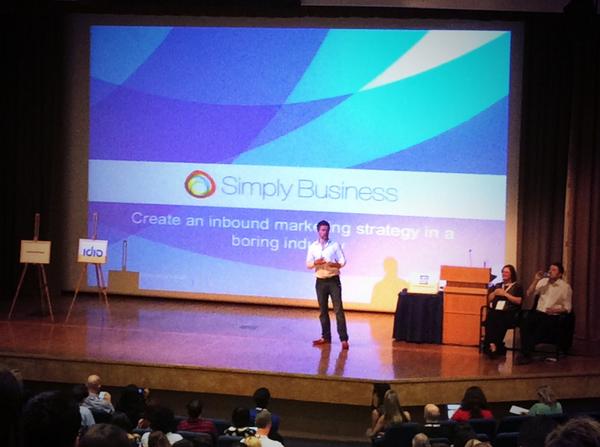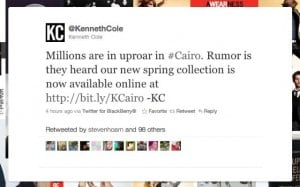72 Takeaways from the Content Marketing Show 2014
If we were to distil the day of learning at the Content Marketing Show into three points they would be: Strategy is King, Storytelling is Key, and It’s All About Data.
We came away with one take home point for every hour of the next three days. Enjoy!
Can a brand ever truly be social?
Takeaways
- A brand can be social and relevant if it communicates on a personal and human level to its social media followers. Be empathetic.
- Brands needs to avoid automating their messages – there is a shift from mass communication to personal communication, and automation leads to lack of thoughtfulness (like below)
- Thinking about the value of a social media update and the potential response and engagement of users is a key to creating messages that resonate with people.
- Don’t post crap on the internet – there’s already enough of it.
How to use data for your content strategy
Johary Rafidison of Grayling PR walked us through his tips for have a data-driven content strategy and introduced us to a couple really cool tools to visualise our data.
Takeaways
- Data is useful to tell story but it needs to be presented in a cool way.
- Most data you need is already available: Insights, Google Trends, Analytics, Keyword Planner
- Use this data to make your story and present it in an interesting way. Tools like Carto DB (mapping, analysis) and Gephi (network analysis) are great.
- Do your research: “Trust what people do, not what they say“
Content Marketing Yearbook 2014: Highlights and low-lifes
Takeaways
- £2.1 billion of ineffective content marketing is being wasted.
- Content marketing serves different objectives: Inspire, Educate, Create an emotional connection, Targeting audience’s beliefs and so on.
- Never sell yourself or your products when you’re content marketing – it’s about the user and your audience.
Case study: create an inbound marketing strategy in a boring industry

Image via @Andrew_Social – Click here for slides
Jasper Martens (@jaspermartens), head of Marketing and Communication at Simply Business made a great presentation about making business interesting and shareable. I definitely wish I had the deck for this one, because there was some serious learning here!
Takeaways
- Effective content marketing on a low budget is about capturing customers higher in the purchase funnel. Instead of spending budgets on PPC, they decided to focus on content and SEO to attract new customers. PPC is competitive, has a high CPA and can have a low ROI. Higher in the funnel, before people are looking to make a purchase, SEO and social media are more important.
- Content provides brand trust and loyalty when it provides value for customers.
- They create relevant content, provide Hangouts, YouTube videos and email newsletters to keep in touch with their customers. Examples: WordPress for Small Businesses, LinkedIn for Entrpreneurs, Guide to Google+.
- Simply Business saw a higher retention rate with customers really appreciating the amount of support post-purchase (in the form of the aforementioned content).
Why people share stuff
Takeaways
- People share things that make them look good; that surprise them or they think will surprise others; that triggers emotions (especially those that make the heart beat faster); useful content; that has an identity (isn’t too generic or has a broad audience).
- Think of people sharing content as individuals managing their brand. What is your audience’s brand?
- Provide content that allows people to show their identity
- Make your content cool, exciting and with unexpected elements
- Ensure that it triggers emotions and can resonate with a small niche
Why Thinking like a Poker Player will Make You a Better Content Marketer
Andrew Tipp (@andrewtipp), Digital Content Development Manager at Suffolk County Council, took us through the kinds of things we can learn from content marketing like a poker player. He did a really great overview of the presentation here.
Takeaways
- Be data-led and analytical – everything begins and ends with data.
- Look for insight (or in poker speak, tells). Focus on what the available information is telling you.
- Sell clients long-term value
- Poker players look for players who are out of their depth. Similarly, in content marketing understand how people are outplaying you.
- Create an original strategy for every campaign. Don’t fall back on what “worked last time”.
- Go for incremental gains: 70/20/10 – 70% bread and butter content (how-to’s, lists – things you know will work); 20% in-depth (white papers, presentations); 10% experimental content.
- Optimise against loss – avoiding big losses is as good as big wins.
- Know when to fold ’em… Learn to let go of what isn’t working.
How a journalistic approach and a magazine mindset improves brand content
Takeaways
- THINK LIKE A JOURNALIST – find the angle, inject life into written content with quotes.
- Have a magazine mindset. People like variety, they browse they scroll… Magazines have a collection of content united under one theme; the variety is there because people are interested in different things about the same topic.
- Interviews improve storytelling and often write the headline and story for you.
- Get your content out – unseen content is useless. Check your facts.
How do you measure Content Marketing? The $44bn question
Here, Andrew Davies (@andjdavies), co-founder of Idio, takes us through how we can prove the value of content marketing to the folks that matter.
Takeaways
- Content is intrinsic to the entire customer journey – it’s not just about marketing so we need to measure leads, utilisation by customers, and conversion.
- Content measurement: content audit – see what resonates with the consumer and evolve a data driven content strategy.
- Audience measurement: Find out who your audience through content listening, building personas and measuring based on these profiles and their behaviour.
- Understand segments and their interests.
- Business measurement: think outside of engagement and look at sales metrics and service metrics.
The Hero’s Journey: using archetypes in video marketing
Ralph Goldberg from Tanglewood shows us how to use archetypes to distil storytelling into its purest form and create a journey that connects with people. As I mentioned here, this was one of my favourite presentations of the day. See the presentation in blog form here.
Takeaways
- An archetype is a short cut to connection because people recognise the characters from other other stories. It’s often a subconscious connection.
- Film evolved to replicate how we dream, which is what makes it such a powerful medium.
- You have 10 seconds to get someone interested and invested in your video, so the faster they can process the characters, the better.
- Using archetypes means the viewer doesn’t have to use their imagination to understand what you’re trying to show.
- Start with the viewer, tweak existing archetypes and tell a good story.
Making animation for the web
Wes West (@wesayso), Designer, Illustrator and Animator at Torchbox, showed us that we can go beyond the confines of video. Is it just me, or does he have the coolest name ever? Get the presentation on Dropbox.
Takeaways
- Animation is great because you aren’t limited to physical space
- You can literally go anywhere with animation
- The process isn’t as long as you might have thought!
Getting Past the Buying Objection with Problem-Solving Content
Takeaways
- Find problems and present solutions. Analyse common themes.
- Know your query types: informational, transactional, navigational, connectivity – they appear at different stages of the buying cycle.
- Find out what people are asking in your niche – look in places like mumsnet, Quora, Stack Overflow, Money Saving Expert, etc. – and create content that answers it.
How to organise successful international blogger event
Takeaways
- Set objectives and select your target audience.
- Bloggers are constantly getting collaboration requests, which can be time-consuming and frustrating at times, so you need to start to build a relationship. Be genuine, and start by connecting with them on social media. Listen to what they have to say before you ask them to do anything.
- Approach local bloggers and build a relationship offline by attending meet ups and sending out custom RSVP invites.
- Be exclusive with bloggers you work with and involve their audience. Engage before a blogger event and stay connected with bloggers after it. Capture media and follow up with them.
- Run these events with the aim of increasing contacts and relationships with influencers that may become beneficial in the future.
Motivational Content Stories For the Down Trodden
Chelsea Blacker (@chelseablacker) from BlueGlass Interactive gave us some tips on creative ways to promote things people don’t want to promote, B2B marketing, and not getting sued.
Takeaways
- Find an appropriate angle when looking at your content.
- Involve professional researchers to give your content more authority and call them instead of emailing them – it is harder to say no on the phone!
- Think of publishers as partners – involve them and they will buy into your project.
- A resource section that can be linked to can help in the content creation for a less exciting industry – utilise internal staff and make them experts.
- If you are unable to promote the product because of laws, then find experts who can and ask them to get involved in the campaign. Turn them from offline into online experts.
- Separate your transactional content from your informational content.
- Do. Know. Go.
Gateway-drug content strategy elements you should use
Charlie Williams (@pagesauce), Content Man at White.net (formerly SEOptimise), gives us some pointers from content strategy that we all should implement into our content marketing campaigns.
Takeaways
- 88% of online marketers are using content marketing in 2014, but only 42% of those have a content strategy in place.
- Always ask WHY you are making the piece of content, what is the purpose of that piece of content, what is the objective or outcome?
- Define your business objective BEFORE creating content.
- Set victory conditions – what are the goals of this content that would make you consider it successful?
- Speak to your business experts (sales or service teams), see what they know about the customers concerns and worries. Use them to gather insight.
- Take a user-centered content approach: undertake research and surveys.
- Keep a content inventory and perform gap analyses.
- This will help you create a framework informed by content strategy to help you create targeted content.
Running and motivating a creative content team
Lisa Myers (@lisadmyers), CEO and Founder of Verve Search, gave an inspirational speech on how she recruits and motivates an awesome, award-winning team.
Takeaways
- Make your own rules. Hire based on chemistry, not on CV. Look out for a candidate’s intelligence, problem solving, passion and attitude. Seize the talent when you see it, not when you need it.
- Pay your employees fair wages. Motivation doesn’t only come from financial awards, trust people to do things in their own way, give them responsibility for their work to inspire pride.
- Always develop your team members. Teach them to disagree and discuss.
- People are motivated by feeling responsible to their peers than to management so encouragement should come everyone: have weekly questionnaires, high fives, in office awards…
Thanks Rough Agenda and the organisers of the Content Marketing Show for putting on such an awesome event. Cheers to Carlo and Verena for sending over their notes from the presentations as well!



